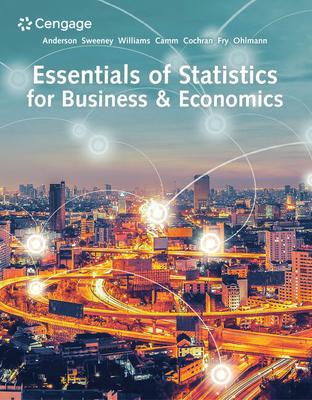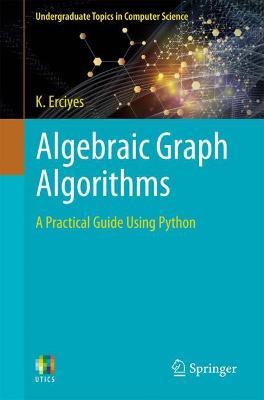Essentials of Statistics for Business & Economics 9th Edition
Essentials of Statistics for Business & Economics Ninth Edition:
Additional ISBNs:
∗ eText ISBN: 0357118197, 978-0357118191, 9780357118191
- See additional information on the Amazon.
More Details
Essentials of Statistics for Business & Economics 9th Edition:
Brief Contents
Contents
About the Authors
Preface
Chapter 1: Data and Statistics
1.1 Applications in Business and Economics
1.2 Data
1.3 Data Sources
1.4 Descriptive Statistics
1.5 Statistical Inference
1.6 Analytics
1.7 Big Data and Data Mining
1.8 Computers and Statistical Analysis
1.9 Ethical Guidelines for Statistical Practice
Summary
Glossary
Supplementary Exercises
Chapter 1 Appendix
Chapter 2: Descriptive Statistics: Tabular and Graphical Displays
2.1 Summarizing Data for a Categorical Variable
2.2 Summarizing Data for a Quantitative Variable
2.3 Summarizing Data for Two Variables Using Tables
2.4 Summarizing Data for Two Variables Using Graphical Displays
2.5 Data Visualization: Best Practices in Creating Effective Graphical Displays
Summary
Glossary
Key Formulas
Supplementary Exercises
Case Problem 1: Pelican Stores
Case Problem 2: Movie Theater Releases
Case Problem 3: Queen City
Case Problem 4: Cut-Rate Machining, Inc.
Chapter 2 Appendix
Chapter 3: Descriptive Statistics: Numerical Measures
3.1 Measures of Location
3.2 Measures of Variability
3.3 Measures of Distribution Shape, Relative Location, and Detecting Outliers
3.4 Five-Number Summaries and Boxplots
3.5 Measures of Association between Two Variables
3.6 Data Dashboards: Adding Numerical Measures to Improve Effectiveness
Summary
Glossary
Key Formulas
Supplementary Exercises
Case Problem 1: Pelican Stores
Case Problem 2: Movie Theater Releases
Case Problem 3: Business Schools of Asia-Pacific
Case Problem 4: Heavenly Chocolates Website Transactions
Case Problem 5: African Elephant Populations
Chapter 3 Appendix
Chapter 4: Introduction to Probability
4.1 Random Experiments, Counting Rules, and Assigning Probabilities
4.2 Events and Their Probabilities
4.3 Some Basic Relationships of Probability
4.4 Conditional Probability
4.5 Bayes’ Theorem
Summary
Glossary
Key Formulas
Supplementary Exercises
Case Problem 1: Hamilton County Judges
Case Problem 2: Rob’s Market
Chapter 5: Discrete Probability Distributions
5.1 Random Variables
5.2 Developing Discrete Probability Distributions
5.3 Expected Value and Variance
5.4 Bivariate Distributions, Covariance, and Financial Portfolios
5.6 Poisson Probability Distribution
5.7 Hypergeometric Probability Distribution
Summary
Glossary
Key Formulas
Supplementary Exercises
Case Problem 1: Go Bananas! Breakfast Cereal
Case Problem 2: McNeil’s Auto Mall
Case Problem 3: Grievance Committee at Tuglar Corporation
Chapter 5 Appendix
Chapter 6: Continuous Probability Distributions
6.1 Uniform Probability Distribution
6.2 Normal Probability Distribution
6.3 Normal Approximation of Binomial Probabilities
6.4 Exponential Probability Distribution
Summary
Glossary
Key Formulas
Supplementary Exercises
Case Problem 1: Specialty Toys
Case Problem 2: Gebhardt Electronics
Chapter 6 Appendix
Chapter 7: Sampling and Sampling Distributions
7.1 The Electronics Associates Sampling Problem
7.2 Selecting a Sample
7.3 Point Estimation
7.4 Introduction to Sampling Distributions
7.5 Sampling Distribution of x
7.6 Sampling Distribution of p
7.7 Properties of Point Estimators
7.8 Other Sampling Methods
7.9 Big Data and Standard Errors of Sampling Distributions
Summary
Glossary
Key Formulas
Supplementary Exercises
Case Problem: Marion Dairies
Chapter 7 Appendix
Chapter 8: Interval Estimation
8.1 Population Mean: o Known
8.2 Population Mean: o Unknown
8.3 Determining the Sample Size
8.5 Big Data and Confidence Intervals
Summary
Glossary
Key Formulas
Supplementary Exercises
Case Problem 1: Young Professional Magazine
Case Problem 2: Gulf Real Estate Properties
Case Problem 3: Metropolitan Research, Inc.
Chapter 8 Appendix
Chapter 9: Hypothesis Tests
9.1 Developing Null and Alternative Hypotheses
9.2 Type I and Type II Errors
9.3 Population Mean: o Known
9.4 Population Mean: o Unknown
9.5 Population Proportion
9.6 Hypothesis Testing and Decision Making
9.8 Determining the Sample Size for a Hypothesis Test about a Population Mean
9.9 Big Data and Hypothesis Testing
Summary
Glossary
Key Formulas
Supplementary Exercises
Case Problem 1: Quality Associates, Inc.
Case Problem 2: Ethical Behavior of Business Students at Bayview University
Chapter 9 Appendix
Chapter 10: Inference about Means and Proportions with Two Populations
10.1 Inferences about the Difference between Two Population Means: o1 and o2 Known
10.2 Inferences about the Difference between Two Population Means: o1 and o2 Unknown
10.3 Inferences about the Difference between Two Population Means: Matched Samples
10.4 Inferences about the Difference between Two Population Proportions
Summary
Glossary
Key Formulas
Supplementary Exercises
Case Problem: Par, Inc.
Chapter 10 Appendix
Chapter 11: Inferences about Population Variances
11.1 Inferences about a Population Variance
11.2 Inferences about Two Population Variances
Summary
Key Formulas
Supplementary Exercises
Case Problem 1: Air Force Training Program
Case Problem 2: Meticulous Drill & Reamer
Chapter 11 Appendix
Chapter 12: Comparing Multiple Proportions, Test of Independence and Goodness of Fit
12.1 Testing the Equality of Population Proportions for Three or More Populations
12.2 Test of Independence
12.3 Goodness of Fit Test
Summary
Glossary
Key Formulas
Supplementary Exercises
Case Problem 1: A Bipartisan Agenda for Change
Case Problem 2: Fuentes Salty Snacks, Inc.
Case Problem 3: Fresno Board Games
Chapter 12 Appendix
Chapter 13: Experimental Design and Analysis of Variance
13.1 An Introduction to Experimental Design and Analysis of Variance
13.2 Analysis of Variance and the Completely Randomized Design
13.3 Multiple Comparison Procedures
13.4 Randomized Block Design
13.5 Factorial Experiment
Summary
Glossary
Key Formulas
Supplementary Exercises
Case Problem 1: Wentworth Medical Center
Case Problem 2: Compensation for Sales Professionals
Case Problem 3: TourisTopia Travel
Chapter 13 Appendix
Chapter 14: Simple Linear Regression
14.1 Simple Linear Regression Model
14.2 Least Squares Method
14.3 Coefficient of Determination
14.4 Model Assumptions
14.5 Testing for Significance
14.6 Using the Estimated Regression Equation for Estimation and Prediction
14.7 Computer Solution
14.8 Residual Analysis: Validating Model Assumptions
14.9 Residual Analysis: Outliers and Influential Observations
14.10 Practical Advice: Big Data and Hypothesis Testing in Simple Linear Regression
Summary
Glossary
Key Formulas
Supplementary Exercises
Case Problem 1: Measuring Stock Market Risk
Case Problem 2: U.S. Department of Transportation
Case Problem 3: Selecting a Point-and-Shoot Digital Camera
Case Problem 4: Finding the Best Car Value
Case Problem 5: Buckeye Creek Amusement Park
Chapter 14 Appendix
Chapter 15: Multiple Regression
15.1 Multiple Regression Model
15.2 Least Squares Method
15.3 Multiple Coefficient of Determination
15.4 Model Assumptions
15.5 Testing for Significance
15.6 Using the Estimated Regression Equation for Estimation and Prediction
15.7 Categorical Independent Variables
15.8 Residual Analysis
15.9 Logistic Regression
15.10 Practical Advice: Big Data and Hypothesis Testing in Multiple Regression
Summary
Glossary
Key Formulas
Supplementary Exercises
Case Problem 1: Consumer Research, Inc.
Case Problem 2: Predicting Winnings for NASCAR Drivers
Case Problem 3: Finding the Best Car Value
Chapter 15 Appendix
Appendix A – References and Bibliography
Appendix B – Tables
Appendix C – Summation Notation
Appendix E – Microsoft Excel 2016 and Tools for Statistical Analysis
Appendix F – Computing p-Values with JMP and Excel
Index





















 Dentistry
Dentistry
Reviews
There are no reviews yet.